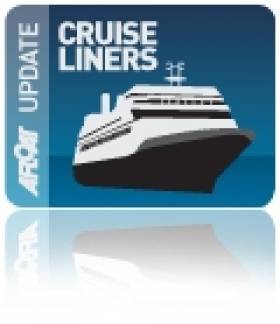Displaying items by tag: Adonia
P&O Cruises Adonia… And the First Shall Become the Last
#CRUISE LINERS – The final cruise caller this year to visit Dublin Port tomorrow is P&O Cruises Adonia, which today is at sea, having departed Cobh Cruise Terminal yesterday, as previously reported. Albeit the smallest in the seven-strong P&O Cruise fleet, she was given pride of place as she led the company's 175th anniversary Grand Event held during the summer, writes Jehan Ashmore.
On that momentous day (3rd July) in Southampton, the 30,000 gross registered tonnes Adonia gathered with her considerably larger fleet mates (69,000 – 115,000 grt) and carrying between them 1,800-3,100 passengers each. Unlike her fleet mates however she exclusively caters for adults only and at only 710 passengers, provides for a more intimate cruising experience.
As each cruise ship took it turns to depart after one after the other, they formed a line down Solent waters where the maritime spectacle was an impressive display in seafaring skills and logistics as thousands of passengers had embarked to include Arcadia whose next port of call was Dublin.
The historic day to mark the origins of the famous company formed in 1837 was the theme of a packed out lecture presented by P&O Cruises Managing Director, Carol Marlow during last months' London Ship Show. Marlow, who was a former CEO of Cunard Line, gave an insightful and entertaining talk of the intensive preparations surrounding P&O Cruises day of celebration.
Despite all the planning, one major event that the P&O team could not arrange was for the sun to shine!..instead a rather misty dull overcast day lingered over the Hampshire port. Having said, many hundreds lined the Solent to watch the sail past as each vessel departed on seven cruises. To view a video of the splendid liners and heritage of the famous company click the series of videos HERE.
As for the London Ship Show which was organised by the Ocean Liner Society, this was to be the last time held under its current format where maritime memorabilia stands and lecture programme where provided to all those interested in the world of liners and ferries operating from the UK.
P&O Cruises Adonia Calls to Foynes
#SHANNON CRUISECALL – P&O Cruises Adonia is visiting the mid-west port of Foynes on the banks of the Shannon port today, writes Jehan Ashmore.
She had made a call to the east coast last week in Dublin Port and the 30,277 tonnes vessel is the second caller so far this year to visit the Shannon region, when the ultra-luxurious Silver Whisper docked in the Co. Limerick port in mid-May.
A further two cruise callers are scheduled, as Le Diamant is also due to call this week on Thursday. The final caller is Amadea, which is expected to close the season next month.
All cruise callers will dock in Foynes which is one of six port facilities along the Shannon Estuary which is under the control of the Shannon Foynes Port Company (SFPC).
The near 700-passenger capacity ship operated by UK based Voyages of Discovery is scheduled to call at several Scotish ports before returning to Portsmouth via the North Sea.
Discovery has eight decks with facilities to include two swimming pools, one with a retractable roof, jacuzzis, lounges, bars, a library and gymnasium, lecture theatre, cinema, restaurants, an internet cafe, shop, beauty salon and a medical centre.
She was built in 1971 as the Island Venture, then renamed Island Princess after purchased by Princess Cruises, alongside her sister Pacific Princess which appeared in the popular US TV series sitcom the 'Love Boat' broadcast by ABC between 1977-1986.
In total there will be four cruise-calls during the season to Douglas but the next visit will be not until July when P&O Cruises Adonia calls on the 17th. The ten-year old 710 passenger vessel is due to be named by Dame Shirley Bassey at a ceremony held in Southampton later this month.
Also calling to Douglas will be Oceania Cruises brand new 60,000 tonnes / 1,250 passenger Marina on the 24th July and the final call is to be made by Noble Caledonia's Japanese built Clipper Odyssey in mid-August.
- Killybegs
- Cork
- Discovery
- Marina
- Ringaskiddy
- Cruise Liners
- Princess Cruises
- southampton
- Isle of Man
- P&O Cruises
- Ports and Shipping News
- Manx
- Voyages of Discovery
- Douglas
- Douglas Bay
- Adonia
- Dame Shirley Bassey
- The 'Love Boat'
- ABC
- Pacific Princess
- Island Princess
- Oceania Cruises
- Cruise Liner news
- Clipper Oydessey
- Noble Caledonia































































